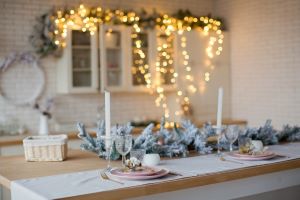
Many homes are transformed into winter wonderlands during the holiday season, decked out with Christmas trees, Chanukah candles, electric lights, paper-wrapped gifts, garlands of winter greens, and many other decorations and ornaments. The Grinch in all this creativity is a higher risk of fire.
Based on statistics compiled a few years ago by the National Fire Protection Association (NFPA), approximately 770 home fires each year begin with holiday decorations, roughly 160 starting with Christmas trees, half of them ignited by electrical sources. Many other holiday fires are caused by candles and cooking: After Thanksgiving, Christmas Day and Christmas Eve are peak days for home cooking fires.
With careful consideration, a dose of common sense and a bit of effort, holiday fire hazards are preventable. For example, prior to decorating with lights, check each cord to make sure they’re UL/ULC-rated, aren’t worn, frayed, or broken, and all the bulbs are tightly connected. The same care and caution should apply to outdoor lights, using clips and not nails to hang them to reduce damage.
It’s also important not to overload electrical outlets with too many holiday lights and household extension cords, which can overheat and cause fires. Check the extension cords for signs of damage and divide them and the lights among two or more circuit breakers. Before turning in for the day, turn off all lights before or use a UL-rated timer to conveniently handle the task for you.
Given the high number of fires caused by candles, place them at least a foot away from curtains and holiday decorations. Keep an eye on them at all times and ensure they don’t burn down to the base. Never display lit candles in places where young children can reach them or outdoors as a gust of wind can easily knock them over. A popular and safer alternative is the use of battery-operated candles; newer versions even have flickering lights and pine-infused scents.
Christmas trees are combustible whether they are artificial or real. Choose a real tree with fresh, green needles that don’t fall off once touched. Cut two inches off the base of the trunk and water the tree-stand daily. Display the tree away from flammable areas like candles and fireplaces. Once pine needles fall, that’s a sign of an improperly watered base, suggesting the tree has a short life span ahead. Artificial trees should be UL-rated, although they, too, can ignite in an electrical fire caused by overloaded sockets.
Cooking during the holidays—in fact at any time of the year—is the leading cause of all reported home fires and injuries. An average of 470 home cooking fires were reported each day in 2018, NFPA statistics indicate, most due to unattended cooking. Tip number one: Stay in the kitchen when cooking on the stovetop. Test smoke alarms and carbon monoxide alarms regularly. And have a UL-rated fire extinguisher in the kitchen in close range of the stove.
As temperatures fall, flaming logs in the fireplace warm the home and hearth and, with stockings dangling from the mantle, look festive. Yet, fireplaces are another cause of holiday fires. Just before winter months kick in, ask a licensed chimney inspector to check for cracked flue tiles, distorted chimney caps, and evidence of masonry deterioration and creosote buildup. Never keep flammable materials like newspaper or kindling wood near the fireplace. Prevent embers from escaping with a metal mesh or glass screen. And dispose of ash and coals at the end of the day in a metal container.
Assuming these various fire prevention tips are given close attention, ‘tis the season now to safely enjoy the holidays!
Jerry Scaini is a Senior Risk Consultant for Chubb Personal Risk Services’ Risk Consulting Group.
The opinions and positions expressed are the authors’ own and not those of Chubb. The information and/ or data provided herein is for informational purposes only and is not a substitute for professional advice. Insurance coverage is subject to the language of the policies as issued.